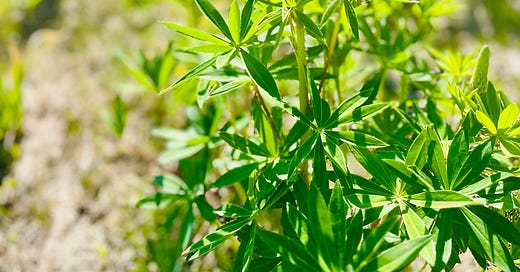Classical Roots is a free weekly newsletter. If you want to support the cause, the best way you can help us is to spread the word.
Four years ago, what is now CCA’s orchard was a biologically inert, chemically-sustained swath of grass. It was, in almost every way, a tidier space. Its luminous green shone in front of the school more or less every day of the year, and classes would occasionally lay out blankets to hold discussions there. Apart from these sporadic human visits, the lawn was more or less a desert. Chemical fertilizers certainly make grass green, but they also edge out or directly kill all organic life right down to the microscopic level, reducing the soil to a sponge that soaks in and expels chemicals, supporting the grass only in the most tenuous sense of that word, the way that a life support system stretches out the bodily existence of someone in a non-recoverable coma.
These days, the orchard is much less tidy—a consequence of it containing actual life. The daffodils and tulips have just gone over, and the alliums and lupins are coming into their own. They’ll be followed by bee balm, black-eyed Susans, and asters. It’s not that tidiness and life are naturally opposed: I myself am very partial to a well-trimmed rose or the clean lines of a mature orchard. It’s just that, as I’ve said before, organic gardens have to embrace awkward stages and moments of development if they hope to achieve their potential, a potential for beauty far in excess of close-mowed grass. An embalmed corpse could, theoretically, be kept perpetually beautiful. But an actual person does not wake up dressed and ready for the symphony. We go through stages of raw, bad-breathed unpleasantness, and this is part of what it means to be alive.
When I first started the Classical Roots Program and began to talk about bringing nature back to campus, the idea was met with enthusiasm. I imagine people were picturing ducklings, colorful songbirds, and jewel-toned dragonflies. And all those animals have indeed come back to campus—it’s just that they have to eat something. Like it or not, ants, mosquitoes, and bees are foundational to ecosystems. We can’t have the loveliness of a swan in flight or the haunting beauty of an owl’s call at dusk without mice, flies, lizards, and other animals that have traditionally been considered pests. Thanks to the industrial production of pesticides and poisons in the Twentieth Century, the standard human reaction to seeing something like a wasp is to carpet-bomb the whole place, satisfied that we can now walk without fear of a bee sting, but ignoring the fact that the chemicles which cleared the space for us cause lymphoma. The recent history of domestic agriculture has given us a false sense of the acceptable risks of living alongside nature. We all know, deep down, that if we live our lives trying to avoid risk, we will still be in danger most of the time—the only thing we’ll actually avoid is life. The same logic applies to our relationship with nature: if we succeed in rendering the outdoors into one big lawn where we’ll never see a bee, we will also bring about our own extinction.
I am, of course, being a little hyperbolic. But it’s worth it to stress a very relevant fact: you cannot only welcome part of nature. You cannot pick and choose which bits of it will live beside you. Nature thrives best in the presence of human stewards but, within that role, we can’t allow ourselves to be biased against whole categories of life. No songbirds without flies, no honey without bees. Two years ago, there were no house finches on our campus. Now, a cluster of them flies twittering away every time I go to the vegetable garden. A mating pair of mallards has taken up residence in our pond, soothing and delighting CCA students as well as our building’s other tenants. None of these things would be possible if we were still spraying chemicals around, or if we hadn’t been willing to tolerate the temporary ugliness of de-silting the pond or digging in the garden in the first place. By the time my son Brody graduates, the orchard in September will be festooned with apples. In spring, the scent of their blossoms will hang over the school at dawn and dusk. The Blue Flag irises will rise out of the pond in June, dipping under the weight of hunting chartreuse damselflies. All of that is worth a little risk—we have to take life as it comes.
If you enjoy what you’re reading here and want to support us, why not subscribe? It’s free to all and you’ll get access to our weekly posts, as well as a weekly subscriber-exclusive chat where we brag about our gardens and beg for advice. It’s the best way to support us.
Also: Tell me what you think! Your comments are part of what makes this program worth doing and this newsletter worth writing. If you have thoughts, advice, questions, or enthusiasm, let me know! Others are waiting to join the conversation.




As I was reading this, my niece came up to me with a housefly she had “caught.” She asked why it walking on her hand but wasn’t flying and I said perhaps its wing was hurt. She walked away to show someone else and I heard her whisper, “I’m sorry for squishing you, bug.”